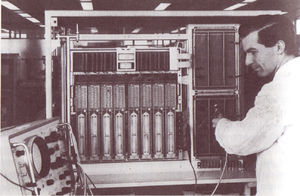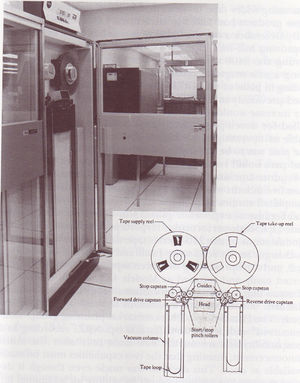IBM System/360
This article was initially written as part of the IEEE STARS program.
Citation
The April 1964 announcement of IBM System/360 was revolutionary in content and unprecedented in scope. It replaced all five of IBM’s (6-bit-byte) computer product lines with one strictly compatible family, using a new hybrid-integrated-circuit technology and a new 8-bit-byte architecture. Six processor models offering a 50-fold performance range were accompanied by 54 different peripheral devices, with a pioneering standard interface providing full interchangeability. The software package included communications network capabilities, 16 different language compilers, and a graduated-function, multiprogramming, disk-based operating system. Innovations of System/360 quickly became de facto standards that reshaped the computer industry and facilitated its sustained rapid growth.
Introduction
The announcement of IBM System/360 on April 7, 1964, heralded the arrival of a new family of computers that reshaped IBM and the entire computer industry. The origins of System/360 date back to 1959.
By all accounts, 1959 would be another good year for IBM. Its success in electronic computers was of particular interest to Tom Watson because he had been given responsibility for developing the electronics business when he returned from military service in 1946. Under his leadership, IBM quickly became the dominant supplier of electronic calculating machines for punched-card systems, and it had just passed Remington Rand as the primary supplier of large electronic stored-program computers in 1956 when Tom replaced his father as CEO of IBM.
Reorganizing for Success
In 1959 Tom Watson’s focus was on future problems, not on past successes. Rapid changes in technologies and market requirements had overextended the capabilities of the company’s Data Processing Division. Major changes were needed.
Watson’s solution was to remove from that division all responsibility for data processing products except for sales and service. Responsibility for market planning, development and manufacturing would be given to two new divisions. The Data Systems Division, with plants and laboratories in Poughkeepsie, New York, would concentrate on large computer systems, typically renting for more than $10,000 per month. The General Systems Division, with plants and laboratories primarily in Endicott, New York, and San Jose, California, would concentrate on smaller systems.
Both divisions would report to T. Vincent Learson, an imposing man of 6 feet 6, who had a well-deserved reputation for being insightful, aggressive, and decisive. He was the only executive Watson thought was smart enough and tough enough to understand and manage the computer business.
Seeking Compatibility
An increasing problem for suppliers of computers, and for their customers, was training enough service men and providing and maintaining software support for many different computer products. There was little interchangeability of hardware or software among competing products or even among IBM’s own products. In 1959 IBM was supporting five different computer product lines.
In his new position, Learson envisioned computer products made in Endicott being compatible with those made in Poughkeepsie, and visa versa. This would reduce the costs of product development, manufacturing, service, and software support, and it would also facilitate the migration of customers from small IBM systems to larger ones. Unfortunately, from Learson’s perspective, the Poughkeepsie engineers had already begun to design what they called the 8000 series of computers to replace the successful 7000 series. If he allowed this work to go forward, it would very likely make it impossible to achieve the interdivisional compatibility he sought.
To solve this problem, Learson replaced the systems development manager in Poughkeepsie with Bob O. Evans, who had played a key role in Endicott in achieving compatibility of the IBM 1410 computer with the highly successful IBM 1401. Three months after his appointment, Evans recommended that work on the 8000 series be terminated and replaced by an interdivisional effort “to develop a total cohesive product line.”
The proposed change in plan was vigorously opposed by Frederick P. Brooks, Jr., architecture manager of the 8000 series. With a 1956 Ph.D. from Howard Aiken’s pioneering computer science program at Harvard and experience as a designer of the IBM Stretch supercomputer, Fred Brooks was an articulate and knowledgeable opponent. Nevertheless, after considerable review, Learson accepted the recommendation of Evans and terminated the 8000 series project in May 1961.
Bob Evans immediately asked Fred Brooks to manage a project to create the “ultimate family of systems.” “To my utter amazement, Bob asked me to take charge of that job after we had been fighting for six months,” Brooks recalls. He eagerly accepted the job, and his knowledge and enthusiasm gained the support of many others.
There was, nevertheless, strong opposition from John W. Haanstra, president of the General Products Division. He was convinced that he, and those who reported to him in the Endicott laboratory, understood best how to compete in the marketplace their products served. In defense of his view, he could cite many product successes, especially the IBM 1401 computer, announced in 1959, and already the best selling computer in the world.
The SPREAD Task Group
To overcome Haanstra’s opposition and to secure the cooperation of others, Learson established a corporate-wide task group with Haanstra as chairman and Evans as vice chairman. Code-named SPREAD (an acronym for Systems Programming, Research, Engineering, And Development), the task group was to “establish an overall IBM plan for data processor products.” Fred Brooks was one of twelve members.
The SPREAD Task Group issued its final report in December 1961. This 26-page report contained many specific recommendations. There would be five processors spanning a 200-fold range in performance. Solid Logic Technology (SLT) being developed by IBM’s new Components Division would be used in all processors. Each processor would be suitable for business or engineering and scientific applications, except that floating-point instructions (not needed for business applications) could be offered either as standard equipment or as a field-installable option. The central processor of each computer would be “capable of operating correctly all valid machine-language programs of all processors with the same or smaller I/O and memory configurations.” The character size used in all machines would be the 8-bit byte, first used in the IBM Stretch supercomputer. All input-output equipment such as tape and disk storage, card readers, printers, and terminals would have a standard interface so they would be interchangeable.
A very important and pioneering recommendation was the use of a small, high-speed memory with permanently stored information to control the action of logic circuits in each processor. Known as a “read-only control store,” such a device would obviate the need to wire into each processor the capability to perform each of the programming instructions required of all processors in the compatible line. IBM’s laboratory in Hursley, England, had conducted extensive studies of control stores, based on a 1951 proposal by M. V. Wilkes at Cambridge University. Their use in the new product line had been vigorously promoted by John W. Fairclough, the SPREAD Task Group representative from the IBM Hursley laboratory.
In operation, each programming instruction (such as add, multiply, or conditional branch) was equated to an address in control store. When the word at this address was read out, its permanently stored 1s and 0s were used to open or close associated computer logic gates as required to execute the instruction. If an instruction execution required a sequence of such settings, (i.e. more than one machine cycle), the first word addressed carried the address of the next control-store word needed to complete the instruction execution.
John Haanstra was supportive of much in the SPREAD report, but he was apprehensive about the following statement: “Since such processors must have capabilities not now present in any IBM processor product, the new family of products will not be compatible with our existing processors.” Haanstra was not alone in fearing that IBM would lose many customers in the effort to move them from their existing computer systems to a new and entirely incompatible line of computers.
Saved by Emulation
The competitive action Haanstra feared occurred in December 1963 when Honeywell announced its low-cost H-200 computer. A program named “Liberator” was available for use in translating IBM 1401 programs to programs that could be run on the H-200. A fivefold improvement in cost-performance over the four-year old IBM 1401 was projected. Within two months, the IBM sales force had reported 196 losses to the H-200.
Haanstra had quietly been preparing an Endicott response to this type of event by using IBM’s new Solid-state Logic Technology (SLT) to build a 1401-type computer. The effort began in late 1960 with the subterfuge of designing a 1401 processor in SLT to provide a “feasibility test of SLT.”
Immediately following the Honeywell announcement, Haanstra converted the “feasibility project” into a full-fledged product development program. The proposed product, tentatively designated the IBM 1470, was scheduled for announcement in February 1964.
It was a blatant challenge to the new product line being developed under the leadership of Bob Evans and Fred Brooks. Evans was dismayed. His vision of a company-wide family of compatible computers seemed to be nearing its end.
Evans knew that IBM engineers in Endicott and Poughkeepsie had worked diligently but unsuccessfully to find a means to help customers migrate from IBM’s many popular computers to the proposed new line of computers. Programs such as “Liberator,” offered by Honeywell to translate IBM 1401 programs to run on the Honeywell H-200 were cost-effective only if the two computers were quite similar. Well-proven methods of simulating one computer with another were also explored, but were also found to be cost-effective only if the two computers were similar.
Then almost miraculously, Evan’s vision of the new product line was saved by an unanticipated use of the control store. For many months, IBM engineers in Poughkeepsie and Endicott had been experimenting with improving the simulation of one computer by another by using additional microcode in the control store. Eventually, the Endicott engineers decided to implement all of the relatively simple 1401 instruction set in an expanded portion of the control store. With a small amount of additional circuitry in the processor, they were able to execute 1401 programs directly, in a cost-effective manner without any software portion of the simulator.
So effective was this method of simulating one computer with another that it was given the name, emulator. Using the emulator, the smallest of the proposed new processors could be run in “1401 mode” to execute programs written for the 1401 four times faster than the 1401 itself. It was a salesman’s dream come true.
Thus it is that the control store made its American market debut, not only as the central feature in achieving compatibility among the computers in the new product line but also as the primary feature of the emulator that saved the line from threatened extinction. (The first commercial use of a control store was in LEO III from the Lyons Computer Company in the U.K. in 1961.)
Product Announcement
On 7 April 1964, the new product line was publicly announced as the IBM System/360. The word “system” was chosen to signify that the offering was not just a group of processors with peripheral equipment but rather an aggregation of interchangeable hardware units with program compatibility from top to bottom. The number “360” (the number of degrees in a circle) was chosen to represent the ability of each computer to handle all types of applications.
The announcement was unprecedented in scope. Six processor models, designated the 30, 40, 50, 60, 62, and 70, were announced. Models 60, 62, and 70 were replaced by superior 65 and 75 models before any of the original three were shipped. Memory capacity on the small Model 30 ranged from 8K to 64K bytes and on the Model 70 ranged from 256K to 1024K bytes. (K is a binary-oriented multiplier equal to 1024.)
A fifty-fold performance range in processors was achieved primarily by two design factors. First, data path widths provided a factor of eight, being one byte wide in the Model 30 and eight bytes wide in the Model 65 and above. Second, SLT circuits provided almost a factor of four with operating times ranging from 8 nanoseconds to 30 nanoseconds. Various design techniques provided the additional factor of two.
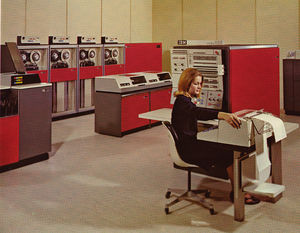
Fifty-four different peripheral devices were also announced. These included several types of random-access magnetic disk storage devices, magnetic tape storage, visual display units, communication equipment, card readers and punches, printers, and an optical character reader. Software support was announced for all hardware configurations. Monthly rentals ranged “from $2,700 for a basic configuration to $115,000 for a typical large multisystem configuration.” (Comparable purchase prices were $133,000 to $5,500,000.)
The response was as unprecedented as the announcement. Well over one thousand orders were received during the first four weeks. Tom Watson had gambled almost all of the company’s development resources for more than two years on a single product line. But the early order rate did not ensure success. Another two years of concerted engineering and manufacturing effort were needed before confirmed orders and successfully delivered products would guarantee fulfillment of the promise of System/360. There were many problems in development and manufacturing, but only those in semiconductor circuits and software support caused major delays in the shipment of System/360 products.
Memories and Control Stores
By the time System/360 was defined, ferrite-core memory technology for main memories had become standard. Such memories were first developed by the MIT Lincoln Laboratory and RCA, and were manufactured by IBM for the United States SAGE air defense system, announced in 1956. IBM’s experience in the SAGE project gave it an advantage, and so did its more recent experience in designing and manufacturing ferrite-core memories for commercial products. For System/360 memories, IBM engineers made yet more improvements, using smaller cores and superior drive and sense circuitry.
Control stores were different. IBM had no commercial products. Its only experimental model was the Transformer Read Only Store (TROS) created for use on the experimental SCAMP computer in the IBM laboratory in Hursley, England. An improved version of TROS was developed in Hursley and successfully manufactured for use on Model 40 of the System/360 line.
TROS probably should have been used on the Model 30 as well, but competition among engineers prevented that. As a result, a new capacitor memory (CCROS) was developed in Endicott and used on the Model 30.
A critical challenge, especially for the faster System/360 processors, was that a control store had to operate at least four times faster than a main memory. The solution was a novel Balanced Capacitor Read-Only Store (BCROS) proposed in the IBM Hursley laboratory and designed in the IBM laboratory in Kingston, New York. These control stores were successfully developed and manufactured for larger System/360 models.
Semiconductor Circuits
At the same time that IBM undertook to design and build System/360, it entered into the components business in order to assure an adequate supply of components and to participate in future advances in technology.
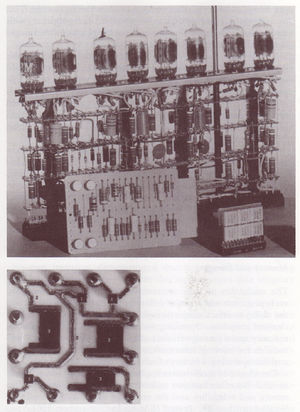
A task force was established to define the best circuit technology for the new line of computers. A key decision was stated as follows: “at the present time, one transistor per chip will yield optimum cost.” The resulting circuit technology, Solid Logic Technology (SLT), inter-connected two or more semiconductor chips on a half-inch (1.2-cm) square ceramic module, on which conducting lines and resistors had been printed. Twelve pins protruding from this ceramic module interconnected it with many more modules on a printed-circuit card, which was itself plugged into a larger printed-circuit board.
Despite problems in the early phases of manufacturing SLT, deliveries proceeded on schedule until managers at the IBM plant in East Fishkill, New York, were ordered (against their best judgment) to increase production from 6 million modules in 1964 to 56 million in 1965. Poor quality resulted, and production was stopped. Scientists brought in from the Research Division worked with the engineers to solve what was found to be a metallurgical problem, and they succeeded. But before they did, IBM had been forced to announce an embarrassing two-month to four-month delay in System/360 shipments.
By 1966 production of SLT modules in the IBM plant in East Fishkill had reached 90 million per year. This was more semiconductor devices than manufactured by all other companies in the world combined. Meanwhile, additional production had begun in IBM plants in Burlington, Vermont, and in Essonnes, France.
Storage Products
IBM had invented a method for using lightweight Mylar tape, coated with magnetic material, for information storage on its IBM 701 computer in 1952. Tape breakage was the key problem solved by IBM engineers by allowing for large loops of tape in vacuum columns placed to either side of the read-write head. This provided sufficient slack to avoid breakage, even in rapid start-stop operations. It was superior to the metallic tape used in UNIVAC and soon became an industry standard. IBM improved the design and manufacturing procedures over the years. The only significant changes made for use on System/360 was the addition of a read-backward capability (already implemented by some other vendors) and an improved head that could read and write nine tracks on conventional half-inch tape to accommodate the 8-bit byte plus an extra bit for error detection.
Following delivery of the first magnetic disk storage device on RAMAC in 1956, IBM rapidly improved the performance and cost of disk storage for use on subsequent systems. Disk diameter was reduced from 24 to 14 inches, storage per unit area was increased over one hundred fold, and a ten-fold reduction in access times had been achieved. Furthermore, stacks of disks were held in interchangeable packs that could be placed on a shelf for low-cost storage. All of these improvements were available when System/360 was announced.
Software Support
General purpose programs, provided “free of charge” by manufacturers, were essential to the marketing of computers. But the magnitude of this task for IBM System/360 was grossly underestimated. Its unprecedented software package included communications network capabilities, 16 language compilers, and a multiprogramming, disk-based operating system. Over one thousand people were employed during the peak year when more money was spent than had been budgeted for the entire project.
OS/360, announced with System/360 in April 1964, was an ambitious full-function operating system, suitable for the largest processor. Moreover, its control program (to be written by the Data Systems Division) was to be comprised of parts that could be selectively omitted to allow for reduced-function versions for use on processors with memory capacities as small as 16K bytes. Despite sustained intensive effort, the various parts of OS/360 were delivered months later than announced.
During post-announcement development, it also became clear that satisfactory performance of OS/360 could not be achieved on processors with less than 32K bytes of memory. To solve this problem, the General Products Division’s responsibility for developing basic programming support for small 8K systems was extended to include separate operating systems for 16K tape and disk systems.
Remarkably, BPS (Basic Programming Support) and TOS (Tape Operating System) were delivered almost on time. DOS (Disk Operating System) was delivered six months late, but it evolved into the most widely used operating system in the world. Some twenty-six releases of DOS, each with enhanced function or performance, were issued by 1971 when IBM decided against creating more versions.
Market Impact
When IBM System/360 was announced in 1964, the major companies of the computer industry were often referred to as Snow White and the Seven Dwarfs. The Seven Dwarfs were Burroughs, Control Data, General Electric, Honeywell, NCR, RCA, and Sperry Rand. Of the estimated $10 billion worldwide inventory of installed computers in 1964, the Dwarfs had produced about 30 percent, and IBM had produced the rest. Five years later IBM’s worldwide inventory had increased more than three fold to $24 billion and that of the Dwarfs had increased by about the same ratio to $9 billion.
This apparent lack of change, other than dramatic growth, is misleading. The popularity of System/360 made it difficult for others to compete across the broad spectrum of the general purpose computer market. RCA attempted to do this by creating Spectrum 70, which was a line of computers compatible with System/360, but marketed at a lower price. Ultimately this was not successful and RCA sold its computer division to Sperry Rand in 1971. General Electric did particularly well with systems for the banking industry and expanded its business in Europe by purchasing Machines Bull and the Olivette computer division. Nevertheless, it failed to make a profit and sold its computer business to Honeywell in 1970.
Only five of the Dwarfs remained after 1971. They were dubbed the BUNCH: Burroughs, the Univac Division of Sperry Rand, NCR, Control Data, and Honeywell. Control Data did well by concentrating on the high end of the computer market. Meanwhile, some new entrants to the market did well by exploiting the very low-cost end, for which System/360 had not been designed. Among these was Digital Equipment Corporation (DEC), whose PDP-8, introduced in 1965 at a purchase price of only $18,000, was very successful. Stimulated by the then-popular miniskirt, someone called the PDP-8 a “minicomputer,” and the name stuck.
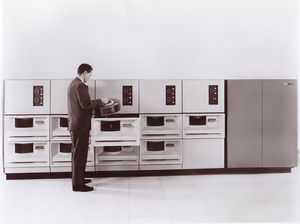
The most significant market impact of IBM System/360 resulted from its pioneering standard interface. This made it easy for others to attach their products to System/360 processors. An entire industry was soon created of companies making and supplying plug-compatible peripheral products. Led by Telex with tape drives in 1967 and Memorex with disk storage units in 1968, this industry enjoyed dramatic growth, partly because IBM’s biggest profit margin was in storage products. Rather than reducing its prices, IBM chose to outrun its competition with rapid improvements in technology.
By 1968, IBM considered leasing companies to be its biggest domestic competitors. These companies entered the market by purchasing IBM equipment and then leasing it to customers at a lower price. They showed a good profit margin by purchasing magnetic tape and disk storage units from manufacturers of IBM plug-compatible products and by assuming a five- to ten-year life for leased equipment, in contrast to the four-year life assumed by IBM.
Incremental Improvements
Even before shipments of System/360 began, IBM management reacted or overreacted to news stories and competitive threats in the market. Among these was the widely publicized assertion that SLT was outdated by monolithic integrated circuits. Overreaction to this assertion was detrimental to the company’s SLT effort because substantial effort was prematurely devoted to developing monolithic integrated circuits. Another threat involved terminal-oriented systems pioneered by MIT and a few other leading-edge customers. In response, IBM announced the System/360 Model 67 in August 1965. It was a modified Model 65 with an entirely different operating system.
As the 1960s came to an end, System/360 needed to be upgraded with integrated circuits and many other hardware and software improvements. The upgraded system was announced in June 1970 as System/370 to signify that it was a system for the 1970s. Its designers had hoped to achieve a dramatic leap forward, but they settled for incremental improvements. Among these was the addition of 6 new instructions to the original instruction set of 143 in order to speed up processing of certain tasks. Any program that used the new instructions would not run on an older System/360 computer, whereas all programs written for the older systems would run on the newer systems.
IBM’s decision to enter the 1970s with a new line of computers, based on System/360, encouraged others to do the same. In 1972 the Soviet Union and its Eastern European allies announced production had begun of their System/360-compatible series of computers. In 1975 the Amdahl Corporation became the first of several companies in the United States, and later in Japan and Western Europe, to begin shipping System/370-compatible processors. The Amdahl Corporation was of major concern to IBM because it had been founded by Gene M. Amdahl, a key architect of the original System/360 line.
Legacy
In 1989, a quarter of a century after IBM/System/360 was announced, products based on System/360 architecture and its extensions still accounted for more than half of IBM’s total revenues. They also accounted for more than 50 percent of the $260 billion worldwide inventory of all computers made by all companies and priced over $100,000 each.
In 2010, the IBM z/90, a compatible direct descendant of System/360, was still an important and profitable product line. Furthermore, many philosophies and design concepts initiated in IBM System/360 survived in all computers given the generic name of “mainframe” or “server.” Among these are modularity of hardware and software, interchangeability of components, compatibility of systems and software, preparing for future needs through many incremental improvements, and the 8-bit-byte.
Acknowledgements
The author is grateful to Frederick P. Brooks, Jr., and John H. Palmer for carefully reading this manuscript and providing many helpful comments. He is also grateful for being permitted to use text, figures, and figure captions from two of his books, which are listed below and were published by The MIT Press.
Timeline
- 1951, M. V. Wilkes introduces microcoding and control store concept
- 1953, IBM 701 computer is first delivered to a customer
- 1959, IBM 1401 Data Processing System is announced
- 1961, IBM Components Division is established
- 1961, SPREAD Task Group issues its final report
- 1963, Honeywell announces its H-200 computer with Liberator program
- 1964, Emulator for IBM 1401 computer is successfully demonstrated in January
- 1964, IBM System/360 is announced on 7 April
- 1964, RCA announces its System/360-compatible Spectra 70 computers in December
- 1967, Telex Corporation offers System/360-plug-compatible tape drives
- 1968, Memorex begins shipping System/360-plug-compatible disk drives
- 1970, First two models of IBM System/370 are announced with monolithic circuits
- 1972, Soviet Union announces its System/360-compatible computer system series
- 1975, Amdahl Corporation begins shipping System/370-compatible processors
Bibliography
References of Historical Significance
M. V. Wilkes. 1951. “The Best Way to Design an Automatic Calculating Machine”. July 1951. Manchester University Computer-Inaugural Conference, pp. 16-18.
SPREAD Task Group. 1961. Final Report of SPREAD Task Group, 28 December 1961. This report is reprinted in the IEEE Annals of the History of Computing, vol. 5, 1983, pp. 6-26.
References for Further Reading
Frederick P. Brooks, Jr.. 2010. The Design of Design: Essays from a Computer Scientist. Upper Saddle River, New Jersey, Addison-Wesley, 2010. Chapters 24 and 25 are case studies of the architecture and software systems of the IBM System/360.
Emerson W. Pugh. 1995. Building IBM: Shaping an Industry and Its Technology. Cambridge Massachusetts: The MIT Press, 1995. Chapters 18 and 19 cover most of the material in this article and more, and also provide background references.
Emerson W. Pugh, Lyle R. Johnson, and John H. Palmer. 1991. IBM’s 360 and Early 370 Systems.
Frederick P. Brooks, Jr.. 1975. The Mythical Man-Month: Essays on Software Engineering. Reading, Massachusetts, Addison-Wesley, 1975. This insightful and humorous book is based on the author’s experiences in managing software development in IBM.
About the Author
Emerson W. Pugh is the author or coauthor of four books on the history of IBM and the computer industry. Two of these books provide the primary basis for this article. Dr. Pugh has a PhD in physics and worked for IBM for 36 years in many capacities, including research scientist, product development manager, and corporate executive. He served as president of the IEEE in 1989, chair of the IEEE History committee in 1996 through 1998, and president of the IEEE Foundation in 2000 through 2004.
